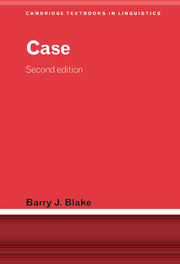Book contents
- Frontmatter
- Contents
- List of figures
- List of tables
- Preface to the Second Edition
- Preface to the First Edition
- List of abbreviations
- 1 Overview
- 2 Problems in describing case systems
- 3 Modern approaches to case
- 4 Distribution of case marking
- 5 Survey of case marking
- 6 Life cycle of case systems
- Notes
- Guide to terminology
- Guide to further reading
- References
- Author index
- Language index
- Subject index
5 - Survey of case marking
Published online by Cambridge University Press: 05 June 2012
- Frontmatter
- Contents
- List of figures
- List of tables
- Preface to the Second Edition
- Preface to the First Edition
- List of abbreviations
- 1 Overview
- 2 Problems in describing case systems
- 3 Modern approaches to case
- 4 Distribution of case marking
- 5 Survey of case marking
- 6 Life cycle of case systems
- Notes
- Guide to terminology
- Guide to further reading
- References
- Author index
- Language index
- Subject index
Summary
Introduction
This chapter provides a global perspective of case systems and their marking. It is divided broadly into two parts. In section 5.2 the organisation of the core or nuclear relations is surveyed and in section 5.3 the organisation of the peripheral relations is described. As Nichols 1983 points out, it is difficult to maintain a strict distinction between core grammatical cases, which encode S, A and P, and semantic cases like locative, allative and instrumental. A single case may cover A and instrumental function or P and allative (destination) function. Nevertheless there are significant generalisations that can be made about cases that encode S, A and P, even if they sometimes cover peripheral grammatical relations as well.
Organisation of the core
As noted in section 3.5.3, noun phrases bearing core relations are often unmarked altogether, while noun phrases in peripheral relations are marked by inflectional cases, adpositions or both. In languages like this the burden of distinguishing subject (SA) from object (P) or the absolutive relation (SP) from the ergative (A) is borne by cross-referencing bound pronouns or word order. On the other hand there are languages with inflectional case only for the core relations, or for these plus possessor function (genitive), with adpositions for other grammatical relations.
In the majority of languages the core grammar is organised on an SA/P basis (accusative system). In a minority of languages the core is organised on an SP/A (ergative) basis.
- Type
- Chapter
- Information
- Case , pp. 118 - 160Publisher: Cambridge University PressPrint publication year: 2001



